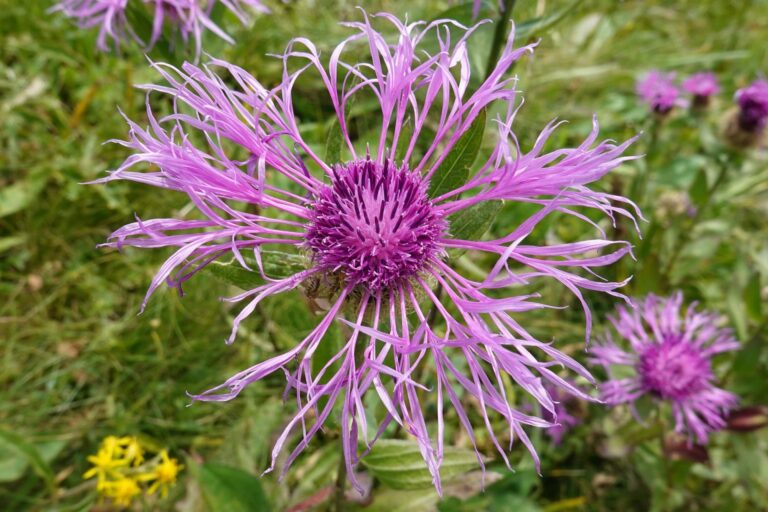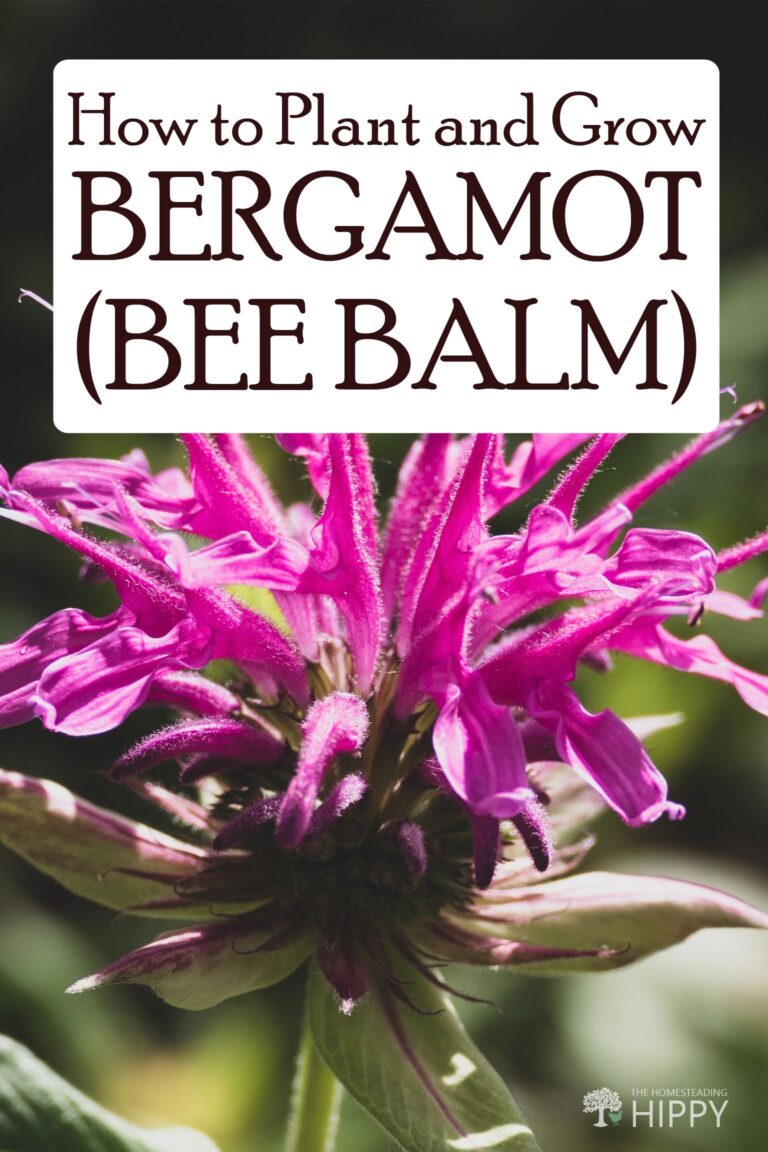Wild Bergamot (a.k.a. bee balm) provides one of the world’s most expensive teas – Earl Grey – with its delicious flavor.

It is hard to believe that this tea had its introduction to western society from the Boston Tea Party in 1773, when colonists dumped 342 chests of tea into Griffin’s Wharf because they were angry at Britain for imposing taxation without representation.
At a loss for tea, thanks to their own tantrums, Oswego Indians introduced the colonists to delicious tea brewed from fresh and dried leaves. The Oswego Indians have been using bergamot for centuries to make Oswego tea.
They believed it had numerous benefits – which have since been largely studied and accepted as a valid remedy to ailments such as digestive issues, spasms, and water retention.
The botanical name for wild bergamot is Monarda fistulosa, but it is also known as Horsemint. Many people mistakenly refer to wild bergamot as Bee Balm. While they are in the same family, they are different species. This article will cover growing wild bergamot.
Bergamot also has a salad/herb species (Monarda fistulosa) and a fruit species called Citrus bergamia which, as the name suggests, produces a bergamot orange. The rind of the orange is what is now used to flavor earl grey tea.
Table of Contents
What Wild Bergamot Looks Like
Wild Bergamot is not the only species in the bergamot family. Wild bergamot is solid pink or lavender in color.
Other members of the bergamot family come in a variety of colors; they can be red, purple, or white. They can also have dark purple dots on the lower lips of their corollas.
The individual flowers are tubular – perfect for hummingbirds.
The leaves appear very much like the leaves of mint. The edges of the leaves are serrated. The main difference being that wild bergamot leaves are longer than their minty cousins. The leaves are lanceolate or ovate. They are 2 to 3 inches long and 1 to 2 inches wide.
Leaves are light green and grow opposite each other on the stem (every leaf will have a twin opposite it on the stem).
The stems are square shaped and if you cut the stem, you will see that the stem is hollow. Flowers bloom for 4 weeks or more during spring and summer.
Benefits of Growing Bergamot in Your Yard
Bergamot is popular because of its multiple benefits to traditional gardeners or gardeners of edible gardens. Some of these are:
- ☑ Wild bergamot attracts bees, butterflies, hummingbirds, and other pollinators to your yard.
- ☑ Bees use its nectar and pollen to make honey.
- ☑ It is also edible and can be used to flavor dishes, it can be added to salads and used as edible garnishing.
- ☑ The leaves can be used to spice venison.
- The flowers and leaves are edible. They can be added to stews, sauces, and roasts to add flavor.
- ☑ The leaves can be used to make tea.
- ☑ It is a very aromatic plant that is very pleasant.
- ☑ It repels mosquitoes; they cannot stand the smell.
- ☑ They have the most fantastic smelling flowers with beautiful pink to lavender colors.
But how do you get bergamot to grow in your yard? It is a lot easier than you expect. It is a very hardy plant that can survive at -20 degrees Fahrenheit (-28 Celsius). This perennial requires very little effort and if cared for properly will grow back year after year.
So, how should you plant it and care for it?
Soil Conditions
Bergamot loves soft soil that holds moisture well. It is well suited to loam, sandy loam, or clay. The soil needs to be well-drained.
The soil will need to be fertilized during the winter months. Sprinkle the ground with fertilizer once a week or add a large amount of fertilizer once per month. I also give the beds fertilizer twice during spring and summer.
You can also add compost. If you have your own compost patch, this will save you the cost of purchasing fertilizer.
Watering
Bergamot is a hardy, wild plant that – while it loves moist soil – does not need much watering. As it is part of the mint family, it will thrive without constant watering.
During winter, water your bergamot once a week. During the summer months, you can water your bergamot once or twice per month depending on rainfall.
If you are growing your bergamot from seed, do not use a hose or watering can to water the trays. The seeds are extremely small and lightweight and will wash away. Always water seedlings with a spray bottle.
The plant is drought resistant; it does not need to be watered often. Your plant will tell you if it needs water. You will see the leaves droop. If you see that, water your plants.
Watering your bergamot also has an impact on the taste of the plant. The less you water the more peppery your plant will be. If you water your beds often (which you absolutely can do), the taste will be diluted, and it will taste more like oregano.
Where To Plant Wild Bergamot
This perennial plant loves morning sun and afternoon shade. Make sure it has a lot of direct sunlight in the morning and that it is sheltered from the sweltering sun in the afternoon. It will do fine with partial or full shade in the afternoon.
The plants do best with at least 6 hours of full sun a day.
How to Plant from Seed
Growing bergamot from seed is very easy. Fill your seed trays ¾ full of fertilizer and carefully pick up seeds on your fingertip (they are tiny). Carefully brush the seeds into the tray and press the seeds gently into the fertilizer (do not bury the seeds, just anchor them).
If you do not want to establish seedlings, simply scatter the seeds on the ground or in potting soil in a pot and use your fingers to press them into the soil.
Germination takes place in 10 to 14 days at 70 degrees Fahrenheit (21 Celsius).
You do not need to add more fertilizer on top of the seeds.
Once the seeds are in the trays, immediately spray with water from a spray bottle being careful not to disturb or wash the seeds out of the tray.
If you are planting from seed, it will take 3 years for the plant to mature completely. From year 3, your wild bergamot will bloom beautifully every year (it does bloom from year 2, but the best blooms start in the 3rd year).
Seed heads begin to form after blooming. It will take them 6 weeks to mature. The tubular seed heads hold seeds. These can be harvested from dead blooms and planted or stored. Place the seeds in an envelope until they are 100% dry.
Once dried, they can be stored in a zip lock bag, or you can store the envelope with the seeds in a vacuum pack. I recommend that you try to harvest some seeds every year. That way you will have seeds if you want to plant more wild bergamot elsewhere in your yard.
Seeds remain usable for 2 years.
How to Plant from Seedlings or Sprouts
Bergamot grows into a very large bush in spring and summer. Spacing the plants properly will help ensure they do not grow unruly and take over.
If you are planting single plants, make sure there is an 11-inch perimeter around the plant.
If you want to plant a row of plants – e.g., along a border fence – plant each plant leaving an 11-inch space in each direction. If you want to plant more than 1 row leave a row gap of 1.7 inches.
You can also plant plants that have been split, these will grow very well. This is ideal because the plant already has roots and is established in the soil.
Because they are so hardy, you can also plant cuttings without roots. In early summer, you can cut shoots 3 to 4 inches long. Plant these into potting soil. In early fall, these can be planted out into your flower beds. They grow roots and establish themselves very quickly.
When to Plant
You can plant your established plant or your seedlings in early spring.
When to Cut the Bushes Back
If you cut the plants back in early summer the plants will quickly grow back and bloom beautifully.
Do not throw the cuttings away. You can replant the cuttings anywhere there is a gap in your yard and the stems and leaves can be dried out to make a delicious tea.
If you find shoots coming up where you do not want them, just pull them out. Because of the shallow rhizomes and the moisture in the soil, it will be very easy to pull out unwanted plants. You can plant these wherever you have a gap in your garden.
Frequently Asked Questions
Q: The leaves and stems of my plant have powdery white spots on them, what is the problem and what can I do about it?
A: This is called Powdery Mildew. Powdery mildew will cause leaves to become discolored. This is purely cosmetic; it is not harmful to the plant.
To correct the problem, keep the ground moist, cut off all diseased leaves, spray the plant with water regularly (try spraying with a power sprayer or turn the tap on full and hit the powder head-on), and try to improve ventilation around the plant. To reduce the reoccurrence of powdery mildew, move clumps of the plants every 2 years to limit the opportunity for mildew to develop.
Q: Can my bergamot get Leaf Spot Fungus?
A: Yes, it can. Just as with Powdery Mildew, this is purely a cosmetic problem. Follow the same process as with the mildew to rid your plants of fungus. Both conditions can also be treated with fungicide (please choose a bee-friendly product).
Q: Will the wild bergamot take over my garden?
A: The roots of wild bergamot are very deep, and the plant is very good at spreading out. Bergamot grows from seeds; therefore, the roots spreading will only thicken the area of the individual plant. New plants can only grow from seeds.
However, if you wet the soil properly, it is very easy to pull out or thin out plants you do not want. It is a bushy plant, so plant it where it can have space. If you do not want it to spread at all, plant it in a pot that will contain the deep roots. The pot will need to be deep as the roots grow deep.
Q: I made tea from the leaves of my bergamot, but it does not taste like earl grey. Did I do it wrong?
A: While tea made from the leaves is healthy and tasty, it will not taste like earl grey because they are made from different plants.
Remember I said bergamot plants are either fruit or salad? Earl Grey is flavored with the rind of the bergamot fruit. Oswego tea is made with the leaves of the wild bergamot.
Q: Should I deadhead my blooms?
A: Yes, deadheading flowers, once they have wilted and died, will give space for new blooms. Remember to harvest the seeds before your throw the blooms away.
Q: Why is my wild bergamot not blooming?
A: The most common reason for wild bergamot not to bloom is a lack of direct sunlight. Try moving your plant to a sunnier spot in your yard.
Q: Is wild bergamot the same as bee balm?
A: Wild bergamot (Monarda fistulosa) and Bee Balm (Monarda didyma) are in the same genus, but they are different species. They look similar and can be grown side by side, but they are not the same plant.
Q: Is bergamot safe for dogs and cats?
A: It is absolutely safe for dogs and cats.
Q: How Big Does a Wild Bergamot Plant Grow?
Wild bergamot can spread out as it has deep, strong branched roots with shallow rhizomes. If it is grown in the correct place and the soil is nutritious and well-fertilized, a single bergamot plant can grow into a bush that is 47 inches high and wide.
Q: Does Wild Bergamot Need Weather Proofing?
Wild bergamot can survive temperatures of -20 degrees Fahrenheit (-28 Celsius). It does not need to be protected from frost. If your yard is hit by heavy frost, that would be a good time to add fertilizer or compost.
Conclusion
Wild bergamot is a beautiful plant that adds fullness to gardens and can be used to mark off property borders, hiding ugly fences. The blooms are a rewarding prize that comes with very little effort.
Whether you want to grow it to make Oswego tea to soothe, calm, relax, or heal, or you want to add the flowers as an edible garnish or to flavor a dish, wild bergamot is delightful and does not need much effort (if any effort) to fill your yard with its delightful scent and draw in pollinators and hummingbirds.


Di-Anne Devenish Seebregts was raised in an environment where daily life consisted of hiking, environmental conservation, growing fruit and vegetables, and raising poultry for meat and eggs.
She combined her passion for the writing word with her love of the pride that comes with not relying on others. She raised three children (who are now adults) to value the environment, and understand the value of being self-sufficient.
Find out more about Di-Anne on our About Us page.

Hi Di-Anne, just love your website. I am confused because I thought that the bergamot used for flavoring Earl Grey tea is a citrus ‘Citrus bergamia’ an actual citrus tree not an annual herb. I look forward to some clarity.
Cheers
Tina
Hi,
So Modern Earl Grey is flavored by citrus trees. The Boston Tea Party saw hundreds of boxes of British spiced tea dumped into the Boston harbor by American colonists demanding lower taxes on tea. Given the loss of spiced British tea, colonist were forced to seek alternative tea. The Oswego Indians came to their rescue with tea made from wild bergamot bushes.